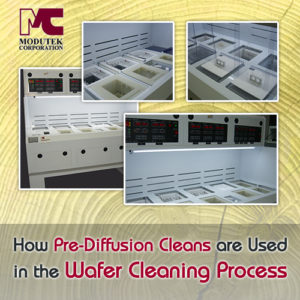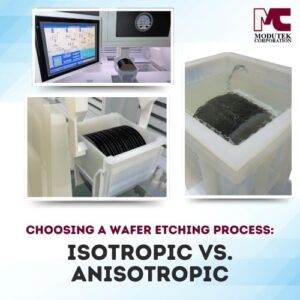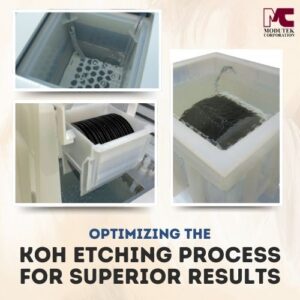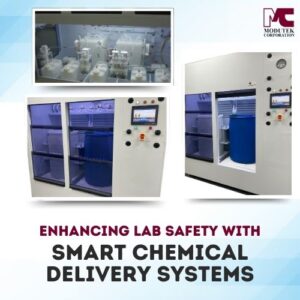 The silicon wafers processed in semiconductor manufacturing facilities and research centers are repeatedly cleaned in aggressive chemical cleaning baths used to remove surface contaminants from the wafers. The cleaning is important because surface impurities affect the diffusion of dopants in the diffusion ovens. Depending on the next diffusion step, wafers have to be completely clean and several types of material may have to be removed. The wafer cleaning process can include multiple cleaning methods to prepare the wafers for the subsequent diffusion step.
The silicon wafers processed in semiconductor manufacturing facilities and research centers are repeatedly cleaned in aggressive chemical cleaning baths used to remove surface contaminants from the wafers. The cleaning is important because surface impurities affect the diffusion of dopants in the diffusion ovens. Depending on the next diffusion step, wafers have to be completely clean and several types of material may have to be removed. The wafer cleaning process can include multiple cleaning methods to prepare the wafers for the subsequent diffusion step.
Organic Material and Photoresist
When the previous manufacturing step included masking, wafers may still have photoresist adhering to their surfaces. Any such materials have to be removed because they will interfere with the doping process. If contamination is heavy, Piranha etch, a mixture of sulfuric acid and hydrogen peroxide is often used. The sulfuric acid dissolves the carbon-based compounds and the peroxide oxidizes the carbon to carbon dioxide, which is given off as a reaction product.
General Cleaning and Metallic Particles
For lighter organic contamination the two-step RCA clean process (originally developed by RCA Corporation) is often used. The first or SC1 step cleans organic contamination from the wafers but not metallic particles. The second or SC2 step removes the metallic particles and creates a protective layer on the silicon surface.
SC1 clean involves immersing the wafers in an aqueous mixture of ammonium hydroxide and hydrogen peroxide. This removes traces of organic matter and non-metallic contaminants but it leaves metallic particles on the wafer surfaces. These particles have to be removed before diffusion takes place because they may otherwise be embedded into the wafer in addition to the desired doping and cause defects in the semiconductor material.
In SC2, a hydrochloric acid and hydrogen peroxide solution in deionized water dissolves the metallic particles and leaves a clean wafer surface. In addition, a passivation layer is created that protects the silicon from further contamination. The wafers are now ready for further processing.
Native Oxide Layer Removal
The SC1 clean results in an oxide layer forming on the silicon wafers, and even if SC1 is not used, silicon oxide forms naturally on the clean, bare wafers. For some semiconductor fabrication steps, the native silicon oxide layer has to be removed. The silicon oxide layer is stable and very few chemicals can attack and remove it. Hydrofluoric acid is often used but it is extremely dangerous to handle and a safe set-up is important. Usually the wafers are dipped briefly into the acid, which acts very quickly. After a rinse with deionized water and drying, the wafers are ready for the diffusion oven.
Other Cleaning Methods
For some semiconductor fabrication processes, Modutek has pioneered wafer cleaning methods that avoid the use of harsh chemicals. Megasonic cleaning uses megasonic sound waves in a cleaning solution to dislodge particles and clean wafers. Vibrations and the cavitation bubbles of the high-frequency waves dislodge submicron particles and remove contaminating films. Modutek’s ozone treatment is a fast and cost-effective alternative to chemical cleaning for some applications. The ozone converts organic residue to carbon dioxide and does not leave metallic particles behind.
With its extensive experience in wet processing applications and its expertise in providing high-quality wafer cleaning process equipment, Modutek can advise customers on solutions for their semiconductor fabrication needs. The company can evaluate specific fabrication processes and suggest equipment from its complete line, ensuring that the proposed stations fulfill requirements safely and effectively. Modutek’s wet benches support the pre-diffusion cleaning processes as well as general cleaning, stripping and etching and they are available in manual, semi-automated and fully automated stations. Contact Modutek at 866-803-1533 for a free quote or consultation to discuss which process equipment will work best to support your application.




